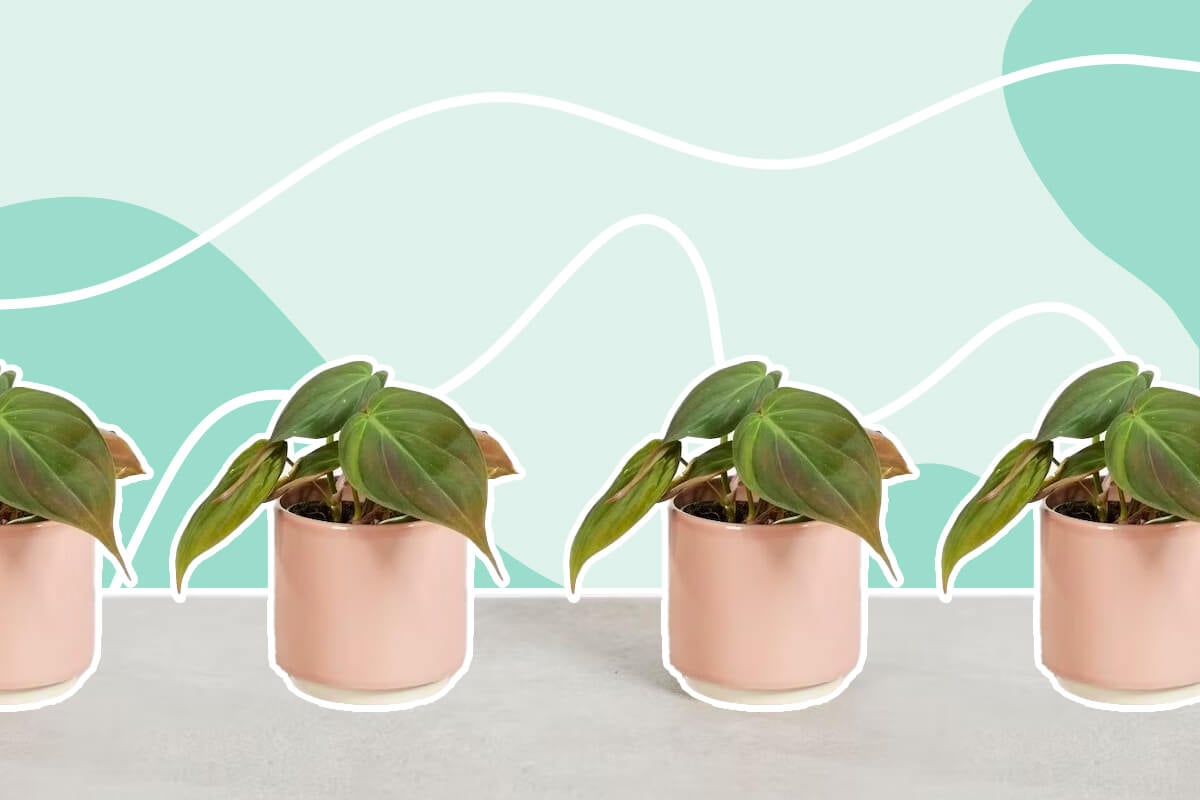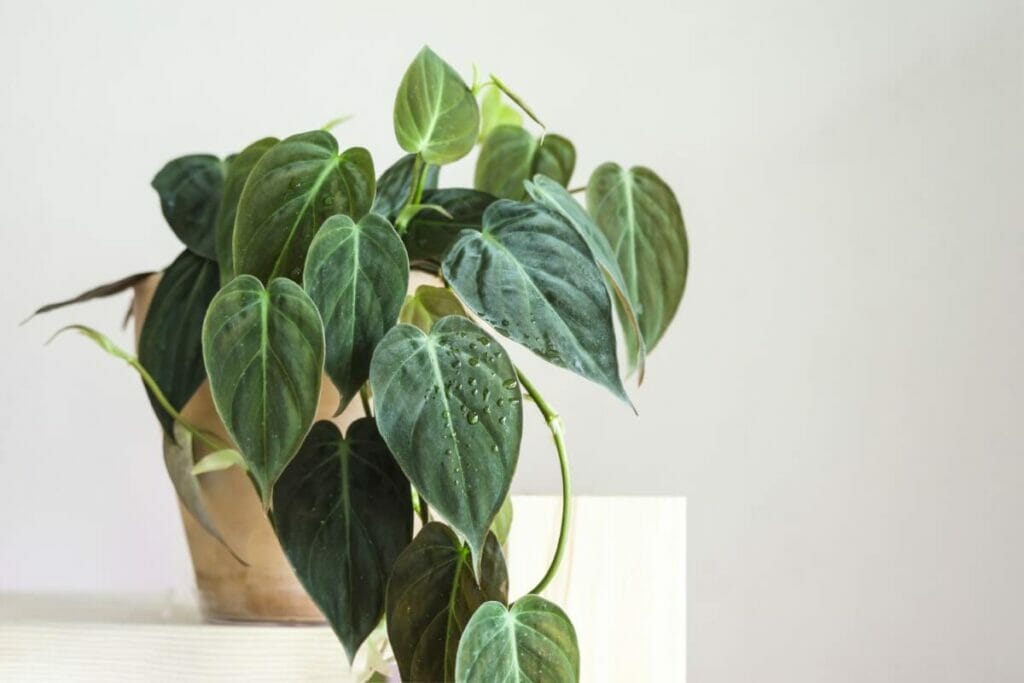Philodendron Micans Plant Care Essentials
With velvety heart-shaped leaves, the philodendron micans is the perfect plant to add a touch of romance or glamour. I love the trailing habit of cascading down shelves or climbing up trellises in my home. What’s more, philodendron micans are easy to care for, in my experience, as long as you follow a few key pointers. In this guide, I’ll run through how I grow and care for philodendron means, including planting, soil, light, watering, pruning, propagating, and fertilizing considerations.

Philodendron Micans Care – Key Takeaways:
| Botanical Name: | Philodendron hederaceum var hederaceum |
| Also Known As: | Velvet leaf philodendron |
| Growing Difficulty: | Easy to care for |
| Light Requirements: | Bright yet indirect light |
| Temp & Humidity: | Thrives in temperatures between 60 to 85ºF and moderate to high humidity |
| Watering Needs: | Water when the top inch of soil is dry; about every one to two weeks in the summer and every three to four weeks in the winter |
| Soil Preferences: | A well-draining soil with a pH of 5.5 to 6.5 |
| Fertilizing: | Fertilize with a balanced fertilizer once per month during the late spring and summer |
| Growth Expectations: | Up to eight inches tall and four feet long/tall |
| Toxicity: | Toxic to humans and pets |
How to Grow Philodendron Micans at Home

Growth Expectations
Philodendron micans is a fast-growing plant in my home. In the proper environment, it can easily grow over a foot each year, much faster than many of my other houseplants.
Plants typically max out at eight inches tall and about four feet wide or long.
What to Do Before Planting
Before you add a philodendron micans to your home or office, you’ll want to ensure you have a place where it can thrive. Indirect light is the most important aspect to look for.
I position mine in a hanging basket near a west-facing window, protected by a sheer curtain, where it receives plenty of bright sunlight throughout the afternoon.
You’ll also want to account for your plant’s growth over time. Even if you bring home a plant that is only a few inches tall, it will grow quickly! If you keep your plant in a pot on a table or desk, it will quickly take over.
With that in mind, I’d recommend growing your philodendron micans in a hanging basket or provide it with a trellis to climb up.
Best Soil Types
Philodendron micans needs a well-draining and slightly acidic soil mix.
Peat-based potting mixes designed for houseplants work well, in my experience. These mixes are typically well-draining and have a pH between 5.0 and 6.5.
If you’d like to make your own potting mix, you’re welcome to do so. To create a mix that works well for philodendron micans, combine the following.
- Two parts peat moss
- One part perlite
- One part pine bark fines
How to Plant
Planting philodendron micans is easy.
The first step is to obtain a proper pot. Terra cotta, ceramic, and plastic pots will all work as long as they have drainage holes. When you’re choosing a pot, pick one that is only a few inches larger than the plant’s root ball.
Once you have your pot, fill the bottom with a few inches of potting soil. Place the root ball into the pot and fill in the remaining space with more soil mix. Water well and you’re good to go.
Light Preferences
Like most philodendrons, these plants thrive in bright yet indirect light. A spot a few feet away from a bright window works well.
These plants can grow well in lower light levels. However, you’ll likely notice smaller leaves or leggy plants.
While plants may be able to tolerate a bit of direct morning light, you should avoid direct light in the afternoon. This intense light can scorch leaves and cause them to die.
Temperature and Humidity
Since philodendron micans are native to tropical areas, they prefer temperatures and humidity that mimic this environment.
Try to keep the air temperature between 60-85ºF. You should also keep your plant away from hot and cold drafts, such as those from heating vents and poorly insulated windows.
As far as humidity goes, these plants prefer moderate to high humidity. Normal household humidity is typically sufficient, but you may need to supply extra humidity if your home is extra dry. I use a small plant humidifier around the plant during extra cold and dry spells which really helps to boost the ambient moisture levels.
To increase the humidity, you can mist the air around your plant a few times a week as well. If you have your philodendron micans grouped with other humidity-loving plants, it may be worth investing in a humidifier.
How to Care for Philodendron Micans at Home

Watering
The key to watering philodendron micans is to find a balance between wet and dry soil. These plants aren’t drought-tolerant, but they will suffer in saturated soils.
A good plan that I follow is to water the plant when the top inch of soil is dry. To check soil moisture levels, stick your finger into the soil near the center of your planter. If you detect moisture at the surface, wait a few more days before you water.
When you water, you’ll want to ensure you moisten all the soil. If you see water escaping through drainage holes as soon as you water, it is likely that the soil isn’t absorbing water. If this is the case, slowly add water until the soil absorbs it.
After you water, it’s essential to remove excess water that has collected in a catch dish below the pot.
Fertilizing
Fertilizing philodendron micans during periods of active growth will help the plant obtain the nutrients it needs.
It’s best to fertilize plants once a month from late spring through late summer. Select a balanced houseplant fertilizer and apply it to the plant.
Pruning
Pruning your philodendron micans will help it remain healthy and full. Before you begin pruning, you’ll need a sharp and sanitized pair of pruning shears.
Use the shears to trim back portions of the plant’s stems. Avoid trimming more than a quarter of the plant’s foliage at one time.
Propagating
While philodendron micans can be a bit difficult to find, propagating these plants is easy. The best way to propagate is via stem cuttings.
Before you propagate a plant, you’ll want the stems to be at least one foot long. Once you have a plant that’s large enough, follow these steps.
- Use a sharp pair of shears or a knife to take a six to eight-inch stem cutting.
- Remove the leaves from the bottom four inches of the cutting.
- Place the cutting in a glass or container filled with water. Make sure none of the leaves are touching the water.
- Set the cutting in an area where it receives indirect light. Change the water every few days.
- After a few weeks, you should see roots beginning to form. When the roots are at least half an inch long you can repot the plant in soil.
Repotting
Philodendron micans plants typically need to be repotted about once every three years. When you repot, choose a new container that is a few inches larger than the original.
When you repot your plant, don’t be afraid if it looks a little unhappy. Philodendron micans can get stressed with change, but they will bounce back in a few weeks.
Common Problems & How to Treat Them

Curling or Drooping Leaves
If you notice your plant’s leaves are curling or drooping, it’s likely due to low soil moisture or humidity.
If the top inch of soil is dry, you need to water your plant. You should also check that the soil is holding water.
Another possible cause of curling leaves is low humidity. This is especially common in the winter when the air is extra dry from heaters. To increase humidity, mist your plant with water a few times a week.
Yellow Leaves
Numerous environmental conditions can cause yellow leaves. Your plant may be receiving too much water, be too cold, or be stressed by environmental changes.
While these plants don’t like the soil to dry out completely, they also don’t like saturated soil. Remember that you should only water when the top inch of soil is dry. You should also make sure you’re using well-draining soil and a pot with drainage holes.
Another cause of yellow leaves is cold temperatures. If temperatures are regularly below 60ºF, your plants may become discolored.
Another cause of yellow leaves is recent changes in a plant’s environment. Your plant may become stressed if you just brought it home, repotted it, or moved it to a new location. As long as you keep the environment consistent, your plant will recover.
Spider Mites
Spider mites are tiny pests that suck the sap out of philodendron micans leaves. As they feed on plants, they can also spread diseases.
Since spider mites are so small, you might notice the damage before you see the pests themselves. Spider mite damage appears as stippling on plant leaves or small, silvery spots. You may also notice thin webs on the undersides of leaves.
If you notice spider mites on your plants, you must remove them immediately. They can rapidly multiply and cover entire plants.
To remove a small number of spider mites, wipe the leaves with a soapy rag. If your plant has a large infestation of spider mites, you can spray it with neem oil or insecticidal soap.
Since spider mites typically come in on new plants, inspect any plant you bring into your home.
Wrapping Up
Now that you know how to care for philodendron micans, it’s time to find one of these beautiful plants to add to your home.
For more, see our in-depth guide to the best types of philodendrons to grow as houseplants.
Briana holds a B.S. in Plant Sciences from Penn State University. She manages a small market garden where she grows vegetables and herbs. She also enjoys growing flowers and houseplants at home.

